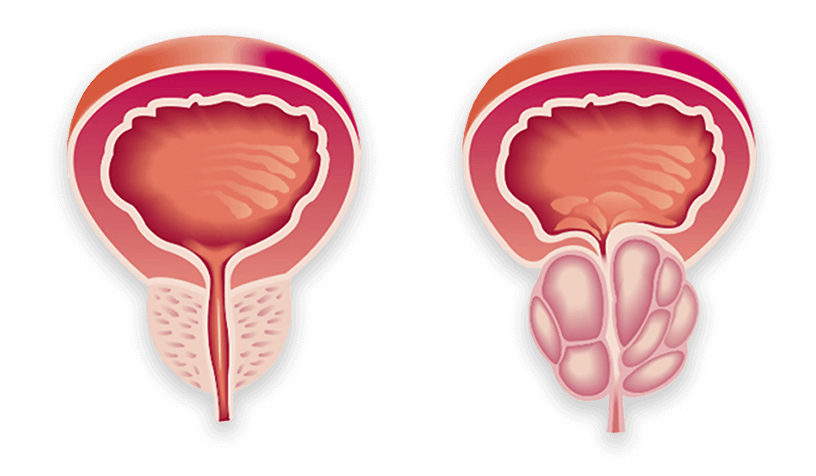
BPH, i.e. non-malignant enlargement of the prostate, is the most frequent pathology of the urogenital system in men above 50 years of age.
BPH – prostate enlargement is commonly associated with burdensome symptoms, collectively called lower urinary tract symptoms (LUTS) (see under BPH-symptoms). Enlarged prostate constricts the urethra (the passage through which urine flows from the bladder) causing problems with urine excretion, which over years may lead to unfavourable anatomical and functional changes within the urinary bladder and the kidneys (such as e.g. bladder outlet obstruction).

Normal prostate
Diagnostic begins with a control visit at the urologist’s, who asks the patient questions about symptoms and complaints associated with the lower urinary tract, including his sexual life and potential erectile dysfunctions.
To assess the severity of lower urinary tract symptoms, the IPSS (International Prostate Symptoms Score) system is used. It is an 8-item questionnaire, consisting of seven symptom questions and one quality of life question. For each question, a score is assigned, and the summary score indicates the degree of severity of the pathology. Additionally, the answer to the question concerning quality-of-life (QoL) informs the doctor how burdensome the problems described by the patient are and how much they disorganize his work, family and social life. Scores from 0 to 7 can indicate mild symptoms, from 8 to 19 – moderate, and 20-35 – severe ones.
The obtained score is approximate in character. The doctor should be asked for interpretation of the result, and make any decisions concerning treatment. To complete the table, click the number in an appropriate column, corresponding to the answer to the particular question, e.g. How often did you experience the sensation of incomplete voiding of your bladder after urination during the last month? If your answer is: Almost always, you should click on number 5 in the same line as the question. Proceed in the same way to mark the numbers corresponding to the answers to further questions. The score resulting from all your answers will be summed up and displayed in the column at the bottom of the table.
Mark only one answer to each question
Międzynarodowa skala punktowa objawów towarzyszących chorobom prostaty
IPSS (ang. International Prostate Symptom Score )
1.
Over the last month, how often have you had a sensation of not emptying your bladder completely after you finished urinating?
2.
Over the last month, how often have you had the urge to urinate again less than two hours after you finished urinating?
3.
Over the last month, how often have you found you stopped and started again several times when you urinated?
4.
Over the last month, how often have you experienced an urgent need to urinate and found it difficult to postpone urination?
5.
Over the last month, how often have you observed a weak stream of urine?
6.
Over the last month, how often have you had to push or strain to begin urination?
7.
Over the last month, how many times (on the average) did you most typically have to get up to urinate at night?
Score


Drukuj wynik


Możesz wydrukować swój wynik i zabrać ze sobą na wizytę do urologa.



Przed użyciem zapoznaj się z ulotką, która zawiera wskazania, przeciwwskazania, dane dotyczące działań niepożądanych i dawkowanie oraz informacje dotyczące stosowania produktu leczniczego, bądź skonsultuj się z lekarzem lub farmaceutą, gdyż każdy lek niewłaściwie stosowany zagraża Twojemu życiu lub zdrowiu.
Nazwa produktu leczniczego: Prostamol® UNO; 320 mg, kapsułki miękkie Skład jakościowy i ilościowy: Jedna kapsułka zawiera 320 mg wyciągu z owoców palmy sabal (Serenoa repens (W.Bartram) Small (Sabal serrulata (Michaux) Nichols), fructus) (9-11:1).Rozpuszczalnik ekstrakcyjny: alkohol etylowy 96% (V/V).Postać farmaceutyczna: Kapsułki miękkie. Owalne, żelatynowe kapsułki miękkie z nieprzejrzystą, dwukolorową czerwono-czarną otoczką, wypełnione brązowym do żółto- lub zielonkawo-brązowego (oleistym) płynem. Wskazania do stosowania: Produkt roślinny łagodzi objawy związane z rozrostem prostaty występujące przy oddawaniu moczu, jak np.: słaby strumień moczu, parcie na mocz, częstomocz, częste oddawanie moczu w nocy. Przeciwwskazania: Nadwrażliwość na substancję czynną lub którąkolwiek substancję pomocniczą wchodzącą w skład produktu. Podmiot odpowiedzialny posiadający pozwolenie na dopuszczenie do obrotu: BERLIN-CHEMIE AG Glienicker Weg 125 12 489 Berlin Niemcy. Aktualizacja: 01.03.2019. INFORMACJA NAUKOWA: BERLIN-CHEMIE/MENARINI POLSKA Sp. z o.o. ul.Słomińskiego 4, 00-204 Warszawa, tel. 22 566 21 00